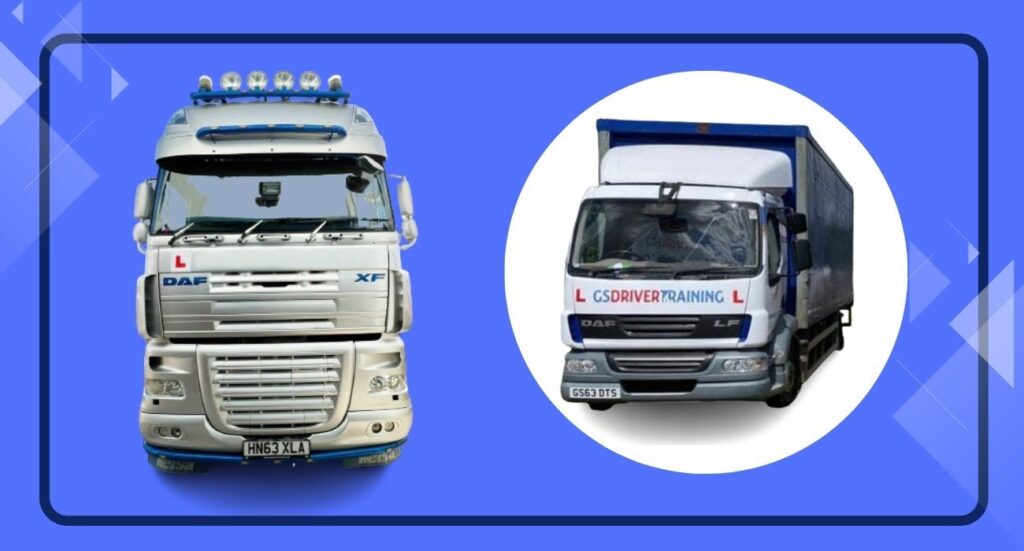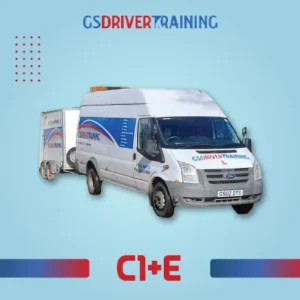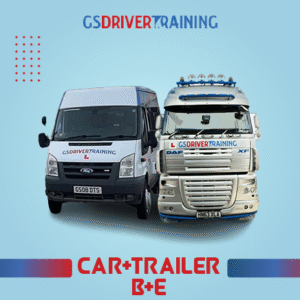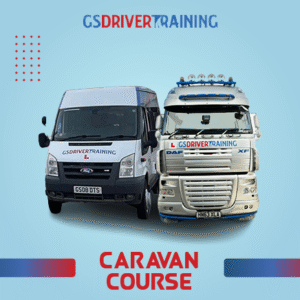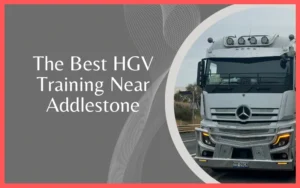Best HGV Training at GS Driver Training
Looking for the Best HGV Training at GS Driver Training? HGV (Heavy Goods Vehicle) training refers to gaining the knowledge, skills, and qualifications needed to operate large commercial vehicles—such as trucks and lorries—professionally and safely. To begin with, ensure you meet the eligibility requirements for HGV training. These vary by region; however, they typically include holding a valid driving licence and meeting minimum age criteria.
Next, choose the type of HGV licence. Regulators group HGV licences into classes—such as Category C1, Category C, and Category C+E—based on the vehicle’s size and weight. Decide which category fits your career goals and the vehicles you want to drive. Pick the right licence now to streamline your training and progress faster.

Find a Training Provider
Research local HGV training schools and choose a reputable one. Pick providers with recognised accreditation and proven, experienced instructors.
Theory Training (Module 1)
Begin with theory training, which includes studying road safety, traffic regulations, and driver responsibilities. This training prepares you for the theory test.
Case Studies (Module 2)
Module 2 involves case studies that test your ability to apply road safety knowledge and regulations in real-world scenarios. You’ll answer questions about how you would respond to various situations.
Practical Training (Module 3)
Practical training (Module 3) involves learning to operate an HGV safely and effectively. You’ll receive instructions on vehicle controls, manoeuvres, and safety procedures.
Vehicle Familiarisation
Become familiar with the specific HGV you’ll use for the practical test. Learn about the vehicle’s controls, systems, and safety features.
Practical Driving Test (Module 3)
Take the practical driving test, which assesses your ability to operate the HGV in real traffic conditions. This test includes vehicle control, hazard awareness, and adherence to traffic laws.
Practical Demonstration Test (Module 4)
Module 4 involves a practical demonstration test where you demonstrate your practical knowledge of vehicle safety and maintenance. This includes vehicle safety checks, securing loads, and using safety equipment.
Pass Your Tests
To obtain your HGV licence, you must pass the practical driving test (Module 3) and the practical demonstration test (Module 4). Pass rates can vary, so thorough preparation is essential.
Periodic Training
After obtaining your HGV licence, you must complete periodic training to maintain your qualification. This typically involves 35 hours of CPC (Driver Certificate of Professional Competence) periodic training every five years.
Employment Opportunities
Your HGV licence allows you to explore employment like long-haul trucking, delivery services, and logistics companies. HGV drivers are in demand in many industries.
Remember that the specific requirements and procedures for HGV training can vary by region and country, so it’s essential to consult the guidelines and regulations set by the relevant authorities in your area. Choosing a reputable training provider is crucial for a successful and safe HGV training experience.
HGV Training Near Me
Finding a reputable HGV (Heavy Goods Vehicle) training provider nearby is simple if you follow a clear process:
1) Start online
Search Google/Bing for terms like “HGV training near me,” “HGV driving schools in Surrey,” or “Class 1 training [your town].” Check directories (e.g., Yelp, Yell) for local listings.
2) Use official sources
Visit relevant government/licensing websites to find approved providers in your area. Recognition by the proper authorities is essential for your qualification to be valid.
3) Ask around
Get recommendations from friends, colleagues, or recent trainees. First-hand feedback helps you avoid poor providers.
4) Check reviews
Read Google Reviews and Trustpilot to gauge reputation, pass rates, customer service, and aftercare.
5) Visit in person
Tour the centre if possible. Look for modern training vehicles, safe practice areas, and professional, approachable instructors.
6) Compare providers
Contact a shortlist (3–5 centres) and ask about:
-
Licence categories offered (C1, C, C+E)
-
Course structure & duration (including 3a/3b test prep)
-
Instructor qualifications and pupil–instructor ratios
-
Vehicle availability and condition (rigid vs artic)
-
Prices, finance, and what’s included (medical, theory, CPC)
-
Scheduling options (weekdays/weekends/evenings)
7) Confirm accreditation
Book only with centres the relevant authorities accredit and recognise; confirm they operate on approved test routes and facilities.
8) Decide with confidence
Balance cost against quality, reviews, and your schedule. A slightly higher price can be worth it for better coaching, vehicles, and pass support.
Follow these steps and you’ll quickly identify a reputable local provider to prepare you for your HGV tests—and a safe, successful start to your driving career.
HGV (Heavy Goods Vehicle) licences
Also called LGV (Large Goods Vehicle) licences in some regions—authorise drivers to operate heavy commercial vehicles used for transporting goods. Terminology aside, the exact categories and requirements differ by country and region. In general, licences are grouped into several categories that define the types of vehicles you’re qualified to drive. Below are some common HGV licence categories:
Best HGV Training at GS Driver Training Category C1 (7.5-tonne licence)
This category allows you to drive vehicles with a maximum authorised mass (MAM) of up to 7.5 tonnes. These are often smaller trucks used for local deliveries and transportation.
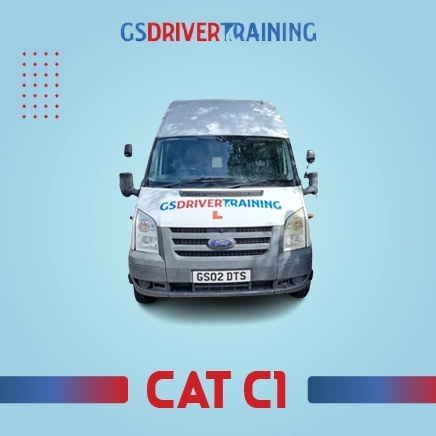
Best HGV Training at GS Driver Training Category C (Class 2 Licence)
Category C licences are for rigid vehicles over 3.5 tonnes in MAM. This includes larger trucks used for various transportation purposes, such as delivery trucks, refuse collection vehicles, and utility maintenance vehicles.
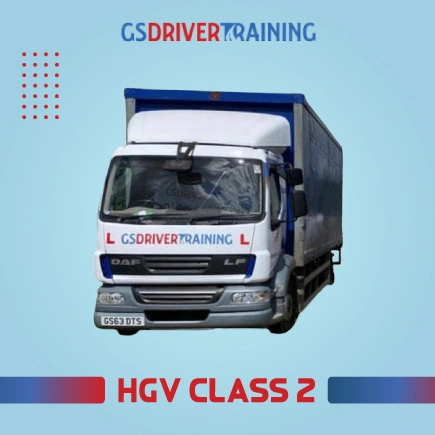
Best HGV Training at GS Driver Training Category C+E (Class 1 Licence)
Category C+E licences are for articulated trucks, also known as tractor-trailers or semi-trucks. These are used for long-haul transportation and typically consist of a tractor unit (cab) and a trailer.
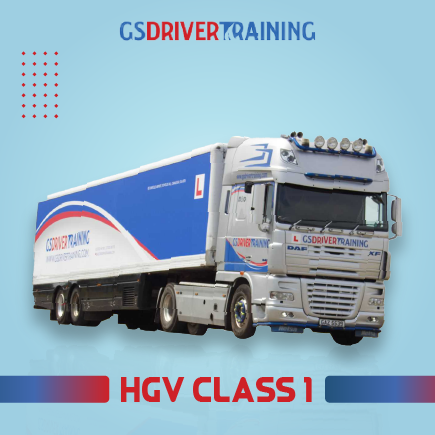
Category C1+E
This category allows you to drive a Category C1 vehicle with a trailer. It’s an extension of the Category C1 licence.
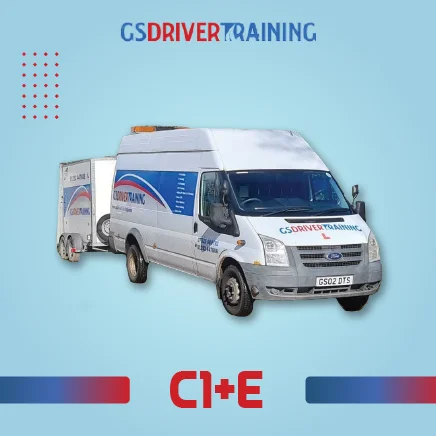
Category D (bus licence)
In some countries, including the UK, Category D licences are required for operating buses and coaches. This category is separate from HGV licences, which are specific to goods vehicles.
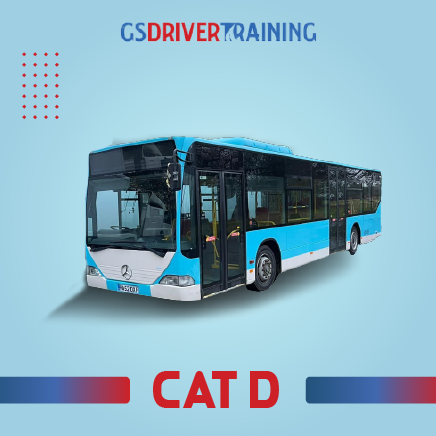
Best HGV Training at GS Driver Training Category D+E (Bus and Trailer Licence)
This category permits the operation of buses and coaches with trailers. It combines the Category D and Category E classifications.
ADR Certification
Hazardous goods transportation often requires additional certification, known as ADR (Accord European relatif au transport international des marchandises Dangereuses par Route), which is based on international regulations for the transport of dangerous goods.
To obtain an HGV licence, individuals typically need to meet certain eligibility criteria, including age requirements, pass a medical examination, complete theory and practical training, and successfully pass the relevant driving tests. The specific requirements and procedures for obtaining an HGV licence can vary by country, so it’s important to consult the licensing authority or agency in your region for detailed information on the process. Additionally, it’s essential to adhere to all safety regulations and drive responsibly when operating HGVs.
Best HGV Training at GS Driver Training FAQ
What is an HGV driver?
An HGV driver is a professional driver licensed to operate heavy goods vehicles, typically large trucks, for transporting goods. HGV drivers play a critical role in the transportation and logistics industries.
What is a 7.5-tonne sense?
A 7.5-tonne licence typically refers to a category of driving licence that allows individuals to operate vehicles with a gross vehicle weight (GVW) of up to 7.5 tonnes. This includes smaller trucks often used for deliveries.
What are HGV training courses?
HGV training courses are programmes designed to provide aspiring HGV drivers with the knowledge and skills to obtain an HGV licence and operate these vehicles safely. They usually cover both theory and practical training.
What is driver training?
Driver training encompasses a broad range of courses and programmes designed to improve the skills and knowledge of drivers. This includes training for various types of vehicles, from cars to HGVs.
What is HGV recruitment?
HGV recruitment refers to hiring and placing qualified HGV drivers with employers in the transportation and logistics industries. Recruitment agencies often specialise in matching drivers with suitable job opportunities.
What is the HGV Recruitment Centre?
An HGV recruitment centre is a facility or agency that connects HGV drivers with job openings. These centres can assist drivers in finding employment opportunities in the industry.
What are LGV driver training courses?
LGV (Large Goods Vehicle) driver training courses are similar to HGV training courses but may focus on a broader range of large vehicles, including those with a GVW below 7.5 tonnes.
What is a truck licence?
A lorry licence typically refers to a driving licence that allows individuals to operate lorries or trucks. The specific category and requirements can vary by country and region.
What is an HGV licence?
An HGV licence, also known as a heavy goods vehicle licence, permits individuals to drive large commercial vehicles, including articulated lorries and rigid trucks.
What is an HGV driver?
A driver is an individual licensed to operate a motor vehicle. In the context of HGVs, a driver is responsible for the safe and efficient transportation of goods.
What is a vehicle?
A vehicle refers to any mode of transportation, including cars, trucks, buses, and HGVs.
Drivers: In the context of HGVs, “drivers” typically refer to individuals who operate heavy goods vehicles.
What are the different vehicles used for HGV training?
HGV (Heavy Goods Vehicle) training typically involves using various types of vehicles to provide aspiring HGV drivers with comprehensive training and experience. Here are the different types of vehicles commonly used for HGV training:
Articulated Lorries (Class 1)
Articulated lorries (artics) pair a tractor unit with a detachable semi-trailer, offering high payloads and flexibility for long-distance work. In HGV training, you’ll learn cab controls, mirror use, and observation routines specific to longer vehicles, along with key skills such as coupling/uncoupling, low-speed manoeuvring, straight-line and offset reversing, and safe, progressive braking. The focus is on smooth vehicle handling, forward planning, and space management so you can operate confidently on motorways, A-roads, and in tight yards.
Rigid Lorries (Class 2)
Rigid trucks are single-unit trucks with no separate trailer. They are used for various transportation tasks, including local deliveries. HGV Class 2 training often involves these vehicles.
7.5-Tonne Lorries (Category C1)
Vehicles with a maximum permissible weight of 7.5 tonnes fall into this category. They are often used for smaller-scale transportation and deliveries. Category C1 licences are required for these vehicles.
Horseboxes
Horseboxes are specialised vehicles designed for transporting horses. HGV drivers may receive training on safely loading, transporting, and unloading horses in horse boxes.
LGV’s (large goods vehicles)
LGV’s encompass a broad category of large vehicles, including those with a GVW (gross vehicle weight) below 7.5 tonnes. These vehicles may be used for various purposes, such as refuse collection, utility maintenance, or small-scale deliveries.
Towing vehicles with trailers
HGV training covers towing trailers of different sizes and types. You learn to handle vehicle–trailer combinations—essential for many HGV roles.
Quality programmes provide varied vehicles and realistic scenarios. You’ll study key concepts in the classroom, then practise on the ground with supervised, hands-on sessions. Instructors coach you through coupling/uncoupling, turning, reversing, braking, and load security so you build the skills and confidence to operate safely on the road.
Also Read: How to get a D1 licence

